A Hungarian Virtuoso

The sixth season of Virtuosos, a unique international classical music talent show of Hungarian origin, concluded this past December. For the first time, it was named ‘Virtuosos V4+’, looking not just for a young Hungarian talent, but also from the other countries of the Visegrád Four (Poland, Slovakia, the Czech Republic) and Serbia. The Hungarian winner was 14-year-old pianist, Ildikó Rozsonits.
see more on page 11
Lunar New Year
Unlike western holidays such as Thanksgiving or Christmas, there’s no set date for the Chinese New Year: the first day of the festive period, according to the lunisolar Chinese calendar, begins on the new moon that appears somewhere between January 21 and February 20, after the winter solstice. In 2021, the celebration starts on February 12 and ends on February 26 with the Lantern Festival.


see more on page 14
LIFTING THE HURDLES
EU-CHINA COMPREHENSIVE AGREEMENT ON INVESTMENT – WITH COMPROMISE FOR SCEPTICS
SEE ANALYSIS ON page 9

JANUARY 2021 HUF 1710 EUR 6




















YOU CAN SUBSCRIBE TO OUR NEWSLETTER












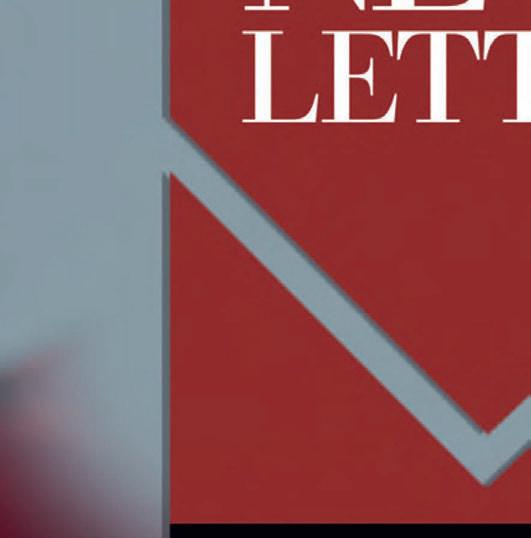






BY READING THIS QR CODE WITH YOUR SMARTPHONE AND FILL IN YOUR DETAILS

letter from the publisher
Just before the end of its Presidency of the Council of the European Union, the German government managed to conclude a comprehensive agreement between the European Union and the People's Republic of China on investments. According to the deal, the Asian country no longer requires European investors – mainly German automakers – to set up a joint venture with a local Chinese partner and forced transfer of technology is also abandoned. Our analysts suggests that can also help Hungarian suppliers gain market access in China.
Azerbaijan wins the second leg of its conflict with Armenia but enmities are likely to continue in this ‘never-ending story’, according to our international analyst. He comes to this conclusion as some of the basic sources of conflict have not been addressed and settled in the southern Caucasus.
Our science page presents the Institute of Advanced Studies in the northwest Hungarian town of Kőszeg through an interview with the founding director and a senior research fellow. Their work is aimed at finding solutions for a better coexistence in Europe.
In culture, we also have a follow-up story from the previous issue where the topic was the regionalization of the classical music TV show ‘Virtuosos’. This time, the 14-year-old Hungarian winner tells us how she saw the show from inside.
This month, WittyLeaks is authored by the departing Mexican ambassador who looks back at his tenure of three and a half years in the Hungarian capital and says how sorry he is about the pandemic restrictions as in diplomacy, “direct human contact is essential.”


Celebrated in dramatic fashion by over 1.5 billion people worldwide, the Lunar New Year (also known as the Chinese New Year or Spring Festival) has more than 4,000 years of history. Explore some of the popular traditions, and learn old Chinese wisdoms and the ancient healing art of Chinese (medical) cuisine in our health article!
The wine page is about Kreinbacher Estate that triumphs at the world’s most prestigious sparkling wine competition, ‘The Champagne & Sparkling Wine World Championships’, winning one gold and two silver medals.
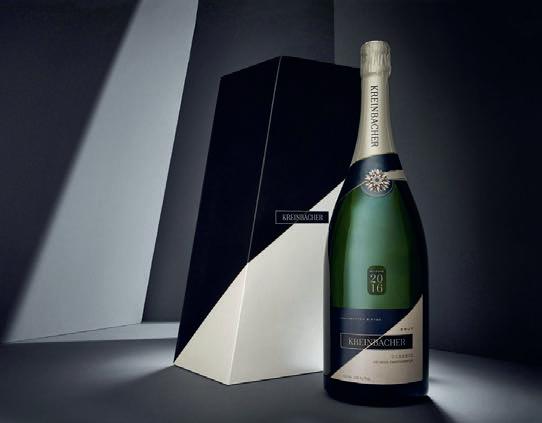
As the pandemic “lockdown” continues, please, stay safe, the vaccines are on the way and we will get through these trying times. We look forward to the “good old days” coming back.
Peter Freed PUBLISHER
cont en ts
12 WITTYLEAKS by the Ambassador of Mexico
Azerbaijan wins the second leg of
EU-China
13 WHAT’S ON Concerts, festivals, events and exhibitions in and out of Budapest

14 HEALTH Chinese New Year
The Kreinbacher Estate
PUBLISHER: Peter Freed EDITOR: Sándor Laczkó PHOTO EDITOR: Dávid Harangozó
SALES & MARKETING DIRECTOR: Tamás Varga ADMINISTRATION: Éva Madarász

CONTRIBUTORS: Sándor Laczkó, Tamás Magyarics, Réka A. Francisck, Csaba Wolf, David Nájera
PHOTO CONTRIBUTORS: 123RF.com (Cover), Bence Hegedűs (Cover), National Directorate General for Disaster Management, Norwegian Embassy, Benedek Sás/ benedeksas.com, mta.hu/Tamás Szigeti, total-waterpolo.com, HIPA, St. Francis Hospital of Budapest, SCHOTT, Bence Fejes, depositphotos.com, 123RF.com, Tibor Ohr, iASK, Bence Hegedűs, Embassy of Mexico in Hungary, David Lynch/Courtesy MEP (Paris, Item Gallery), Museum of Fine Arts, Trafo, Live Nation, Csaba Barbay and Bogi Juhász/Flashback Photo, MTI Photos: Szilárd Koszticsák, Tamás Kovács
HUNGARIAN FOCUS – COMING SOON
In line with the regular country focus compilations on mainly economic relations between Hungary and other states around the national day of the given country, Diplomacy&Trade will publish a Hungarian Focus in its March 2020 issue in connection with the national holiday on March 15 (that commemorates the 1848 Hungarian revolution). According to plans, the leading material of the compilation will be a comprehensive interview with Minister of Finance Mihály Varga on the current status and development plans of the Hungarian economy and the compilation will introduce the most well-known Hungarian companies / brands (irrespective of their ownership structure) to the international readership of Diplomacy&Trade (including the foreign missions in Budapest).

JANUARY 2021 |DIPLOMACY & TRADE| www.dteurope.com 4 Copyright 2004-2020 DUAX Kft., all rights reserved ISSN 1589-8075 This magazine is produced by DUAX Kft. The opinions published in the magazine do not necessarily reflect the opinions of DUAX Kft. photo by EMBASSY OF MEXICO IN HUNGARY, LIVE NATION, CSABA BARBAY/FLASHBACK PHOTO, SHUTTERSTOCK.COM We welcome inquires for advertising in this issue. PLEASE CALL TAMÁS VARGA FOR FURTHER INFORMATION +36 209 350 250 - tvarga@budapestweek.com AND DON’T FORGET monthly in print - daily on the web www.dteurope.com
COPIES ARE AVAILABLE AT SELECTED RELAY AND INMEDIO OUTLETS IN MAJOR HUNGARIAN CITIES. NEWSSTAND PRICE: HUF 1,710 or EUR 6 - Subscriptions are available for an annual fee of EUR 72 in Hungary, or EUR 90 to all other destinations. SEND REQUESTS AND INQUIRIES TO DUAX KFT. H-1034 Budapest, Bécsi út 60. TELEPHONE [+36-70] 320-3051 | FAX [+36-1] 350-5660 E-MAIL editor@dteurope.com | ADVERTISING tvarga@budapestweek.com 05 ON THE RECORD 06-07 COMPANY BRIEFS 08-09 ANALYSIS
conflict
on investments 10 SCIENCE
Studies Kőszeg (iASK) 11 CULTURE
–
Hungarian winner
its
with Armenia;
agreement
The Institute of Advanced
Virtuosos
the
15 WINE
page 13
Event guide to the Hungarian capital
page 15
Hungarian winery triumphs at international contest
Direct human contact is essential page 12
FIRSTCOVID-19 VACCINEADMINISTERED INHUNGARY
Adrienne Kertész, the chief physician of the infection control department of the South Pest Central Hospital, was the first to receive the coronavirus vaccination in Hungary. She was vaccinated on December 26 by chief infectologist János Szlávik. She said she had been waiting a long time to receive the vaccine, because that could decide whether she could continue to work safely and calmly.

István Vályi-Nagy, the director general of the South Pest Central Hospital, said that those working in the intensive care units of the South Pest Central Hospital and the surrounding hospitals would be vaccinated first, to be followed by those working in the emergency departments, after which the vaccination would continue with the general departments.
A few days later, Pfizer Pharma Trade announced at an online press conference that a total of 4.4 million doses of vaccines would be delivered to Hungary in 2020-2021.
Krisztina Zsigmond, head of the company's vaccine business, said that globally, Pfizer would distribute 50 million doses of the vaccine against coronavirus, developed jointly with BioNTech, by the end of 2020 and 1.3 billion doses by the end of 2021. The European Commission has ordered 200 million vaccines and has an option for an additional 100 million doses until the end of 2021.
on the record
AGREEMENTREACHED ONTHEEEAANDNORWAY GRANTS
In December, Norway signed new memoranda of understanding with the Hungarian government on the EEA and Norway Grants, in which EUR 214.6 million in funding has been allocated to Hungary. However, the allocation of funds cannot begin until a fund operator for civil society funding is agreed upon.

According to a statement by the Norwegian Ministry of Foreign Affairs, the MoUs ensure that independent funding is made available to civil society organizations, and that support for climate change measures, renewable energy, business development and innovation is strengthened.
The MoUs also contain important provisions for local and regional development and the social inclusion of the Roma people.
HUNGARIANRELIEFAID TOCROATIA
The Hungarian disaster relief agency OKF sent a shipment of six pallets of aid to Croatia to deal with the aftermath of the December 29's earthquake. Croatia turned to the European Union for help to deal with the magnitude 6.3 earthquake, asking the Member States for tents, lighting, folding beds and sleeping bags. Hungary was one of the first to help its southwestern neighbor and offered 250 folding camp beds and 250 sleeping bags, which Croatia accepted. The two-ton, sixpallet relief consignment departed from the logistics base of the disaster management the day after the temblor to the Croatian civil defense depot near Zagreb via the Letenye border crossing.
Previously, Hungary sent an aid shipment to Croatia on March 23, 2020. At the time, it was to help to deal with a situation following a magnitude 5.6 earthquake with 200 camp beds and 200 mattresses.

‘After a long process of negotiation, it is positive that we have finally reached agreement on the framework for EEA and Norway Grants funding to Hungary in the current period. It is especially important to us that funding is made available to civil society and that the fund operator will be independent of the Hungarian authorities,’ said Minister of Foreign Affairs Ine Eriksen Søreide.
The MoUs were signed by Norway’s Ambassador to Hungary Trine Skymoen and Hungary’s Minister of State for EU Development Dr. Szabolcs Imre Ágostházy in Budapest.

With a total allocation of EUR 214.6 million, Hungary is the third largest beneficiary of EEA and Norway Grants funding. The MoUs now signed apply to the funding period for 20142021, but projects in all beneficiary countries can be carried out until the end of April 2024.
Agreement on independent fund operator is a condition for the transfer of EEA and Norway Grants funding during the current funding period. This applies to all EEA and Norway Grants funding, not just for civil society, and this means that no programs can begin until the fund operator for civil society funding has been agreed upon.
NEWAMCHAMPRESIDENT
At the 23rd General Assembly, the American Chamber of Commerce in Hungary (AmCham) membership elected Zoltán Szabó, Country General Manager of BT-ROC as President, succeeding Dr. Farkas Bársony after four successful years, a statement by AmCham said in December. ,As for other positions, Dr. Dávid Kőhegyi, Local Partner, Head of Compliance and Investigations at DLA Piper Budapest won the contest for the second vice presidency, following the two-year tenure of Kevin A. Murray, Citi’s CEO for Central Europe. Furthermore, four new board-members-at-large were selected by the members: Róbert Bencze, Director of People & Organization at PwC Hungary; Péter Csucska, Managing Director & General Manager of Lexmark International Technology Hungary; István Katona, Managing Director of Celanese Hungary and Orsolya Ludvig, Director of Marketing & Communication of NNG joining the governing body while Ildikó Beck, Ph.D., co-founder and owner of Beck to Nature was re-elected for another two years.
ACADEMIAEUROPAEA: NEWHUBINBUDAPEST
The new Academia Europaea (AE) Budapest Knowledge Hub is the latest addition to AE’s growing number of hubs joining Barcelona, Bergen, Cardiff, Tbilisi and Wroclaw, the website of the Hungarian Academy of Sciences reported. The academic director of the Hungarian center, located in the building of the Hungarian Academy of Sciences, will be László Lovász who was President of the Hungarian Academy of Sciences until this summer.
The aim of the Academia Europaea Budapest Knowledge Hub, established on December 9 and starting its operation on January 1, 2021 is to promote interdisciplinary scientific discourse with a regional and European focus through stimulating new links and networks of expertise in the wider Danube region. Its activities are organized along four thematic missions – Widening European participation; The Danube region; Methodology of science education; and Urban sustainability.
The work of each thematic mission of the Hub is coordinated by co-chairs: one senior Hungarian member of AE and one member of the Young Academy of MTA, the latter with the specific assignment to help the involvement of younger generations in Hub actions.

HUNGARIAN ELECTED TOPWATER POLO PLAYER OFTHE CENTURY
The professional website total-waterpolo.com has named Hungary's three times Olympic champion Tibor Benedek as the best player of the 21st century in men's water polo. The decision was based on 40 expert votes and 50,000+ public votes to announce Tibor Benedek and American Maggie Steffens as the greatest among the timeless legends. In addition to Tibor Benedek, who died in June 2020 at the age of 48, the top five among the men includes two more Hungarians: another triple Olympic champion Tamás Kásás (who finished third in the vote) and 2008 Beijing Olympic champion Dénes Varga. Among the women, the best Hungarian position in the vote was achieved by Mercédesz Ambrus who was elected into the second team of the 21st century.

www.dteurope.com DIPLOMACY & TRADE| JANUAURY 2021 5 photo by SZILÁRD KOSZTICSÁK/MTI, NATIONAL DIRECTORATE GENERAL FOR DISASTER MANAGEMENT, NORWEGIAN EMBASSY, BENEDEK SÁS/BENEDEKSAS.COM, MTA.HU/TAMÁS SZIGETI, TOTAL-WATERPOLO.COM
NATIONAL DAYS January 1Cuba National Day 26Australia National Day February 6New Zealand National Day 15Serbia National Day 16Lithuania National Day 23Japan National Day 24Estonia National Day 25Kuwait National Day 28Egypt Independence Day
UPCOMING
company briefs
IBM EXPANDING IN SZÉKESFEHÉRVÁR

IBM Client Innovation Center in Székesfehérvár, which provides IT services, server operation, system management and development as well as cloud-based services, has decided to expand. The almost EUR 9.7 million investment, to be realized by December 31, 2021 will be carried out while retaining the current number of employees. What is more, the company will create 300 new jobs.
A report by the Hungarian Investment Promotion Agency (HIPA) says the task of new colleagues is planned to be related to the remote monitoring of computer software systems. Remote monitoring means the supervision of the functioning of operational and financial activities, teamwork promoting and corresponding, as well as production support systems of foreign clients.
JYSK DONATES BEDCLOTHES TO BUDAPEST HOSPITAL

The Hungarian subsidiary of JYSK, an international department store chain with Scandinavian roots, handed over a donation of bedding to the Szent Ferenc Hospital in the Hungarian capital in December.
Since the spring of 2020, when the coronavirus epidemic took over the world, JYSK Hungary has repeatedly supported healthcare institutions with product donations to help patients recover in more beautiful wards and to make the rest rooms of heroic and tireless healthcare professionals more comfortable. At the end of November, JYSK received a request from the Szent Ferenc (St. Francis) Hospital in Budapest to support the hospital with bedding to ensure the care of new patients who are constantly arriving due to the COVID-19 epidemic. JYSK was happy to comply with the request to support the hospital’s newly opened inpatient ward by offering 50 quilts, pillows, bedding sets and sheets.
The HUF 1 million bedding donation was handed over by store manager Bernadett Bárdosi Turcsányi to Judit Hostyánszki, Economic Director of St. Francis Hospital in Budapest and to Controller Mónika Szenti Pálerni.
IBM also maintains close relations with institutions of higher education in Hungary; their Dual Education Program was officially launched in 2015, leading to 71 students joining their centers from Óbuda University and Corvinus University.
Hungary has become one of the leading international centers of business services in the Central and Eastern European region over the past decade, and based on the latest data from HIPA, 131 Business Services Centers offer 63,892 people jobs and longterm career opportunities.
TECHNOLOGY-INTENSIVE IMPROVEMENTS BY SCHOTT IN HUNGARY
25-year-old SCHOTT Hungary, owned by the German Carl Zeiss Foundation, is launching an investment project on its site in Lukácsháza, W Hungary. A report by the Hungarian Investment Promotion Agency says that 16 items of highly-automated, new generation, Industry 4.0 production lines will be put in service in the pharmaceutical glass and packaging material manufacturing unit. This will be financed from EUR 41 million, together with the establishment of a production and service building. SCHOTT Hungary Ltd. is a key plant in Hungary, producing primary pharmaceutical glass packaging materials. The company started its operation in Lukácsháza 25 years ago, and has been producing high quality packaging materials for the pharmaceutical industry ever since. In the pharmaceutical sector the Hungarian unit is considered to be the largest manufacturing plant of the Mainz-based SCHOTT group, which is solely owned by the Carl Zeiss Foundation. This investment on the Hungarian site will involve the purchasing of 16 highly automated production lines, which will be equipped with advanced, energy efficient, high speed and highly automated, new generation measuring and IT devices. An appropriate hall will also be built to accommodate the technology.
The hundreds of millions of vials and capsules, which constitute the annual output of these new production lines, will be distributed to all major pharmaceutical companies in Europe, in order to enable the safe use of any vaccine or medicine filled into them. The SCHOTT products will among others store and contain the vaccine against COVID-19.

Porsche Hungaria Ltd. and Mercarius Ltd. offered ten more passenger cars to the National Humanitarian Coordination Council (NHKT) to control the epidemic. The vehicles – of Volkswagen Jetta type – were handed over at the courtyard of Semmelweis University’s Internal Clinical Block this December.

Students participating in the screening for new coronavirus infection received five cars through the National Ambulance Service, while the Imre Magyar Hospital in Ajka, the Balassa János Hospital in Tolna County, the Bethesda Children's Hospital in Budapest, the St. Rafael Hospital in Zala County and the BorsodAbaúj-Zemplén County Hospital and Teaching Hospital received a car each.
SCHNEIDER ELECTRIC INVESTMENTS IN HUNGARY
Schneider Electric has made an investment of EUR 12 million in its factories and logistics center in Hungary in 2020, the electronics company informed the Hungarian state news agency MTI.

As part of the developments, the existing production hall in the company's Gyöngyös (east of Budapest) plant was expanded by 2,800 square meters, new production lines were put into operation and the IT infrastructure serving production was renewed, and the number of 100 employees at the end of 2019 was increased by 10%.
The Gyöngyös plant also plays a special role in Schneider Electric's global production, one of the three plants in which the company
produces busbars. Technological development was also carried out at the company's MG Zala plant where new production lines were put into operation. The project is a major step forward in the automation of production processes, increasing efficiency.
At Schneider Electric's logistics center in Szigetszentmiklós (just south of the capital), CEELog, among other things, IT developments and projects increasing the efficiency of material handling have been carried out.
JANUARY 2021 |DIPLOMACY & TRADE| www.dteurope.com 6
PORSCHE HUNGARIA OFFERS CARS TO HELP COMBAT EPIDEMIC
photo by HIPA, ST. FRANCIS HOSPITAL OF BUDAPEST, SCHOTT, TAMÁS KOVÁCS/MTI, DEPOSITPHOTOS.COM
company briefs


BATTERY PARTS FACTORY TO BE BUILT IN GÖDÖLLŐ


Kedali Hungary Ltd. will invest EUR 40 million in a new factory in Gödöllő (just east of Budapest) that will become an aluminum structural component part provider for Samsung SDI.
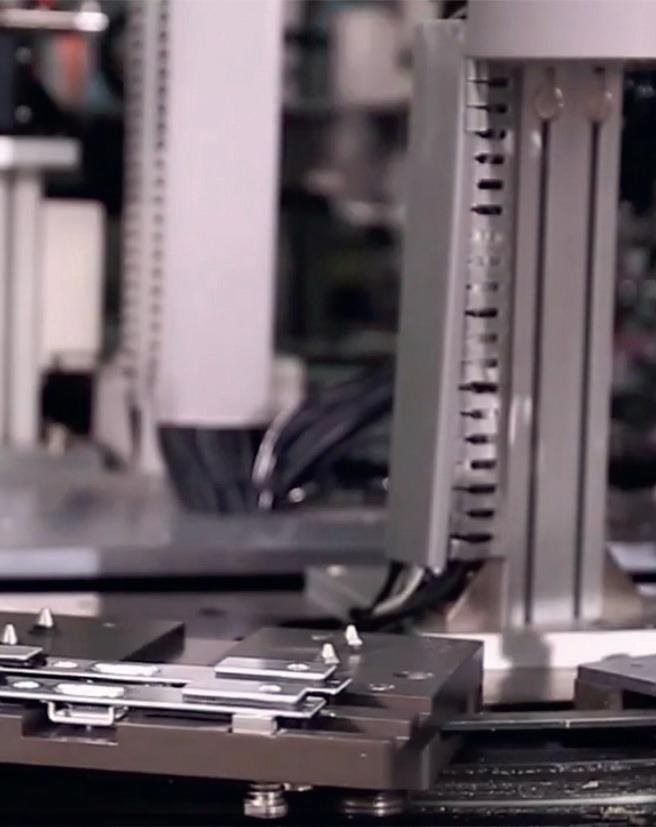
As the Hungarian Investment Promotion Agency reports, the plant's trial run is expected to start in spring next year, while serial production will reach its peak by 2024, resulting in the creation of 330 new jobs.

The Shenzen Kedali parent company, headquartered in Shenzen, China was founded in 1996. The company researches, develops, produces and sells precision parts for lithium batteries and vehicles. Their primary products are precision lithium batteries for energy storage, portable lithium batteries and vehicle parts. The products are primarily used in electric vehicles, portable electronic devices, electric tools and energy storage applications.




HUNGARIAN-BELGIAN PHARMACEUTICAL AGREEMENT





The Hungarian pharmaceutical company Richter and the Belgian pharma firm Mithra strengthen their partnership with the signing of a license and supply agreement for the commercialization of a novel oral contraceptive to Latin America.

Gedeon Richter Plc. and Estetra S.A, the wholly owned subsidiary of Mithra Pharmaceuticals, have announced that they extended their partnership and signed a license and supply agreement for the commercialization of a novel 15 mg estetrol (E4) / 3 mg drospirenone containing combined oral contraceptive, in order to include key markets in Latin America, according to the released press statement.
The product candidate is considered a novel oral contraceptive with natural, native estrogen acting selectively in tissues combined with additional benefits of drospirenone. Richter and Mithra partnered for the commercialization of this novel oral contraceptive in Europe and in Russia earlier. Under the terms of this agreement, Richter will distribute Mithra’s product in key markets in Latin America (Mexico, Chile, Colombia, Peru and Ecuador) with an option for other markets except for Brazil and Argentina. Richter made upon signature of the contract an upfront payment. Additional milestone payments will be made depending on the progress of the regulatory process of the product. Besides, further sales related milestones will become payable to Mithra subsequent to the launch of the product. Moreover, Mithra and Richter agreed on minimum annual quantities and Mithra will receive tiered royalties on net sales. Currently, Europe and Latin America are respectively the second (EUR 1.6 billion) and third (EUR 1 billion) largest world markets in terms of value, behind the United States.
“We remain committed to the development and commercialization of Women’s Healthcare products that support the improvement of the quality of life for the female population in all age groups. This transaction is considered to be a further strategic move to strengthen Richter’s direct position in Latin America and at the same time to become gradually a global Women’s Healthcare player,” Richter Chairman Erik Bogsch commented.
The plant in Gödöllő will enjoy a competitive advantage for its geographical location, both as a provider for the battery manufacturers in Hungary and on the European market. The production at the Gödöllő plant will have a positive effect on the company's global market share and will also boost their competitiveness. There will be six production lines added in the first two years of the development, and altogether ten lines will be installed by 2024.
Vodafone Hungary and the Delta Group have signed a strategic cooperation agreement with the aim of enabling the widest possible range of domestic companies to participate in the revolution of 5G technology. By leveraging the continued rollout of the 5G network and 5G solutions, companies, regardless of size and industry, can dramatically improve their competitiveness, a press release by Vodafone Hungary points out. In order to spread the solutions based on 5G technology as widely as possible, it is essential to unite the actors of the infocommunication market and to establish strong partnerships. Vodafone Hungary and the Delta Group will work together as strategic partners in the future to involve as many domestic businesses as possible in this technological revolution, especially in the Industry 4.0 and Smart City service segments. With more than 100 million IoT connections, Vodafone is a world leader in IoT solutions, and the service provider was the first to bring the nextgeneration mobile network, i.e. 5G, to Hungary.

Both technologies are essential to the roll-out of both Industry 4.0 and Smart City solutions. As one of the leaders in Industry 4.0 solutions, the Delta Group offers solutions in a wide range of areas such as robot control, custom machine building, marking, sorting and control technology solutions, sensor networks, industrial monitoring and control platforms –complementing Vodafone IoT and 5G in many areas.
The Hungarian oil and gas group MOL supported the large-scale Christmas relief campaign of the Hungarian Interchurch Aid with a donation of 2,300 liters of hand and surface disinfectant. The charity service delivered 500 servings of hot meals a day to those in need for five days this year. Due to the epidemic situation, food was pre-dispensed and then delivered to hard-hit families and homeless people. Since the beginning of the coronavirus epidemic, MOL has continuously donated its own disinfectant to healthcare institutions, municipalities and some summer daycare camps. In December, the National Ambulance Service, child protection and aid organizations received the Hygi.
“The work of child protection and charitable organizations, such as the Hungarian Interchurch Aid, is perhaps needed more than ever in this difficult and uncertain period. That is why MOL, as a responsible company, has decided to support the work of these organizations with 12,000 liters of MOL Hygi during the holiday period. Since the beginning of the pandemic, we have donated a total of 45,000 liters of disinfectant,” the Communications Manager of MOL Hungary, Piroska Bakos stated.
www.dteurope.com DIPLOMACY & TRADE| JANUARY 2021 7 photo by DEPOSITPHOTOS.COM, HIPA, BENCE FEJES
M Y CM MY CY CMY K Diplomacy-n-Trade.ai 1 2017. 02. 27. 11:22:30
HELPING COMPANIES IN THE TECHNOLOGICAL REVOLUTION
MOL GROUP DONATES DISINFECTANTS TO RELIEF CAMPAIGN
A NEVER ENDING STORY?
BY TAMÁS MAGYARICS
The breakup of the Soviet Union in December 1991 brought to the surface a number of previously hidden ethnic conflicts. The one which was the bloodiest, and which received at that time the greatest attention in the outside world was the war in Chechnya. Later on, the Russian-Ukrainian conflict got into the limelight – primarily because of its important geopolitical repercussions. The third ongoing – alternately – cold and hot war is between the Azerbaijanis and the Armenians.
Another multiethnic conflict
At the center of the conflict is the Armenian enclave within Azerbaijan, Nagorno-Karabakh. The enmities between the two ethnic groups flared up in the late 1980s and early 1990s, and they ended with a sort of victory for the Armenians in 1994, though the disputed territory was recognized as one belonging to Azerbaijan by the international community. (In reality, religion is also playing some role, as the Armenians are Christians and the Azerbaijanis are Muslims.) As it happened in a number of other multiethnic countries – the breakup of Yugoslavia comes into mind –, one of the preferred solutions was ethnic cleansing or, in politically correct terms, population exchange. In this case, some 600,000 Azerbaijanis, and a similar number of Armenians were expelled or forced to leave their homes, thus leaving a bitter taste in the mouth of both sides. An uneasy ceasefire characterized the situation for the next two decades or so, with occasional shootings and skirmishes, which left dead behind on both sides. In April 2016, a fourday intensive conflict broke this pattern, and despite the fact that it ended within a short time, it was clear that the question was not whether there would be another armed clash between the two sides, but when it would break out. It came in the fall of 2020.

Russia and Turkey: additional dimension
Armenia and Azerbaijan alike introduced martial law in late September 2020, and in the ensuing war thousands got killed. The war was finally put an end with the mediation of the Russians in early November. This time, it is the Azerbaijanis who won. Baku is allowed to hold on to territories it has taken during the war, and Yerevan has to contend with keeping control of part of the area it practically governed before the war. The peace-broker, Russia will be sending some 2,000 troops to patrol the frontline and to keep the Azerbaijanis and the Armenians apart from each other and, as things are standing at the moment, Turkey will also be contributing peacekeeping troops. Russia’s and Turkey’s role adds an additional dimension to the ethnic conflict. The relatively keen interest taken by Moscow, Ankara and Tehran, as well as a weaker but visible interest in the
situation by the U.S. lifts this conflict out of present-day run-of-the-mill ethnic clashes. Russia has a vested interest in maintaining relatively normal relations with Armenia and Azerbaijan, too. Having said that, the Russians have shown more sympathy towards the former; Moscow is formally a military ally of the Armenians, and it is Yerevan’s major weapons supplier. (In point of fact, Russia also sells weapons to Azerbaijan.) The appearance of Russian troops inside the internationally recognized territory of Azerbaijan is not a cause of happiness in Baku, either. Moreover, despite the fact that Russia and Turkey are coordinating policies now in this conflict, the two countries’ rivalries in Central Asia are well-known, as their conflicts in the Syrian civil war showed it. Turkey and Armenia are at loggerheads with one another: the ongoing dispute over the Turkish responsibility of hundreds of thousands of ethnic Armenians in the mid-1910s poisons the relations between the two countries. So, Ankara is seen as Azerbaijan’s No. 1 supporter in this conflict. The Turks provide military and diplomatic aid; in fact, possibly, Turkish troops were actively involved in the recent war. According to Armenian sources, Turkish fighter planes downed Armenian aircraft,
while Baku only acknowledged the presence of Turkish F-16s at Azerbaijani air bases, but it denied their active role in the fights.
More countries involved
Iran is also officially neutral (like all the other outside countries on paper), but is said to leaning towards Armenia. This preference has been realized so far only in limited economic cooperation. Tehran’s major worry is not the Armenian-Azerbaijani conflict per se; it is watching closely what the U.S. is doing along its northern borders. Washington is, again, of two minds regarding the Armenian-Azerbaijani conflict. Officially, the U.S. is supporting Azerbaijan’s territorial integrity, but the U.S. Congress has taken significant pro-Armenian steps recently. It, for instance, passed the Freedom Support Act in 1992, which – among others – banned any assistance to Azerbaijan in the armed conflict at that time. Similarly to Russia, the U.S. is providing military aid to both countries. It was President Trump who shifted the bulk of military aid to Azerbaijan (from USD 3 million in fiscal year 2016-2017 to USD 100 million in fiscal year 2018-2019). This change was due to the Trump Administration’s new policies towards Iran: instead of the P5+1 framework,
Donald Trump preferred unilateral action on Iran, and the increased military aid to Baku has served, partly, to increase pressure on Tehran.
Conflict sources remain
The agreement brokered by Russia on November 9, 2020 does not really satisfy either side. The loss of territories provoked antigovernment demonstrations in Yerevan, and it is quite likely that some politicians would like to ride the wave of anti-Azerbaijani feelings, and would promise the retake of lost lands. The Azerbaijanis did not get everything they wanted, either, and the presence of Russian troops in Azerbaijani territory is not an ideal solution for Baku. Another unknown is whether any of the regional neighbors would like to take unilateral advantage of the situation any time in the future, and if yes, it is bound to trigger countermeasures by others. As was suggested with regard to the Versailles peace treaty in 1919, ”It is not a peace treaty, it is only an armistice for twenty years.” The agreement signed in November 2020 might be even shorter-lived than the Versailles peace treaty, as some of the basic sources of conflict have not been addressed and settled.
JANUARY 2021 |DIPLOMACY & TRADE| www.dteurope.com
8 illustration by DEPOSITPHOTOS.COM
analysis
Tamás Magyarics is a foreign policy analyst
AZERBAIJAN WINS THE SECOND LEG OF ITS CONFLICT WITH ARMENIA BUT ENMITIES ARE LIKELY TO CONTINUE
LIFTING THE HURDLES
EU-CHINA COMPREHENSIVE AGREEMENT ON INVESTMENT
An important agreement between the European Union and the People's Republic of China was announced on December 30, 2020. After seven years of negotiations and presentation of arguments, the detailed fundamentals of the EU-China Comprehensive Agreement on Investment (CAI) were laid between the parties.
BY CSABA WOLF
The agreement aims to balance the investment environments and conditions in the EU and China. The major component of this equalization is the easing of strict rules in China and the opening up of new industries for EU investors. The agreement presents new advantages and freedom for foreign direct investment coming from the Union to the PRC.
No more joint venture requirements
In the manufacturing sector, China has made comprehensive commitments, excluding only the sectors with significant overcapacity. These are important points of the agreement, as nearly half of the European FDIs in China is in the manufacturing sector. In the automotive sector – which is very important for Germany – , China has agreed to remove and phase out joint venture

requirements. After signing the CAI, EU car makers will be able to establish 100% foreign-owned factories or assembly lines. The joint venture requirement was a four-decade-old rule in China in the automotive industry, starting with the first foreign automotive industrial investment in Shanghai by Volkswagen. (A few months ago, Volkswagen announced its intention to buy 50% of the shares in the Chinese automotive giant, Anhui Jinghai Automobil, the owner of JAC Motors, Volkswagen's Chinese partner company. The investment value was set around EUR 900 million.)
China has agreed to remove the joint venture requirement in a number of other industries as well. It leaves a wider playground for establishing private hospitals and clinics in major cities like Beijing, Shanghai and Tianjin, as well as large southern cities like Guangzhou and Shenzhen, which is the technological hub of China.
Chinese leaders have started to open up the financial sector for foreign financial institutions, with the removal of the joint venture requirement in the banking sector considered to be a huge step in the liberalization efforts. European banks and insurance companies will be allowed to invest in China without the forced partnership with a local professional partner institution. Joint venture requirements were also lifted for companies providing rental and leasing services in the real estate sector. After signing the agreement, European advertising agencies and market research companies can also operate in China without sharing the ownership of their Chinese entities with local partner organizations. The new investment agreement presents remarkable advantages and multiplies the business opportunities for forwarding and logistics enterprises. Without the joint venture requirement, they can provide door-to-door shipping services to their international customers without depending on a local forwarding partner in China.
Forced transfer of technology abandoned European negotiators succeeded in reaching an agreement about very clear rules against the forced transfer of technology with China. After validating the agreement, investors
of the EU countries in China will not be forced to share their technology secrets even with their joint venture partners. These rules would also include disciplines on the protection of confidential business information collected by administrative bodies from unauthorized disclosure. The United States is not expected to be happy about the announcement of the EU-China CAI, and some European countries have also expressed their concerns about the quick announcement of the deal. While this announcement coming after seven years of negotiations cannot be considered "sudden," Italy and Poland strongly recommended waiting until it can be negotiated with the Biden administration. These two countries, together with Belgium and Spain, also raised some human rights issues against the early announcement of the CAI, with Italy also expressing criticism against the "German engine" (referring to chancellor Merkel, President Ursula von der Leyen and Trade Department Director Sabine Wayand) pushing through with the agreement one day before the end of the German presidency.
Compromise for sceptics
Despite the arguments, all 27 member states eventually came to an agreement. As a compromise for those who are sceptic, EU countries can still valuate and oppose planned Chinese investments based on possible national security risks even after the agreement is signed by both parties. Hungary has supported the CAI from the beginning, as the agreement is in line with the country's economic interest. Hungarian-Chinese economic relations have been traditionally good, which in the past 10 years have been developing at a remarkable rate and opening up the Chinese investment environment in front of EU companies can mean direct and indirect advantages for Hungarian entrepreneurs. A big number of Hungarian companies are suppliers of huge EU – mostly German – manufacturers, so widening their markets and productions will also benefit Hungarian suppliers. We must also mention that more and more Hungarian company owners are interested in Chinese opportunities, not only as regards market entry but in relocating their production facilities as well. While their number and investment value are still low compared to bigger countries' investors like Germany or France, the upward trend is recognizable. The removal of the joint venture requirements and the new rules against forced technology transfers eliminate their main concerns against investing in China. The agreement announced on December 30 doesn't mean that mutual investments can immediately start according to the new set of rules. Taking into account EU bureaucracy, the CAI will be ready for final signing by the first half of 2022.
Csaba Wolf is Senior China Advisor at Baker McKenzie
analysis www.dteurope.com DIPLOMACY & TRADE| JANUARY 2021 9 photo by 123RF.COM
WE NEED TO WORK ON THE FUTURE!
iASK FOCUSES ON INTERDISCIPLINARY STUDIES AND INNOVATIVE REGIONAL DEVELOPMENT

TO OFFER SOLUTIONS FOR A BETTER EUROPE

The Institute of Advanced Studies Kőszeg (iASK) was established in 2015 with the aim of helping to navigate the complexities and uncertainties of this age, contributing to the formulation of solutions to pressing problems that require complex and interdisciplinary thinking, and developing a new vision and strategy for small city development.
The soul of Europe in jeopardy
BY SÁNDOR LACZKÓ
iASK was founded at a time of great global uncertainty and growing interdependence. As American-Hungarian permanent research fellow at the Institute, Jody Jensen tells Diplomacy&Trade, the world has since become even more complex and “this recent pandemic is a very good metaphor to show how interconnected we all are and how responsible we should be for each another.” iASK’s founding director, Ferenc Miszlivetz adds that “Jody wrote a book about ten years ago about global governance and its contradictions. Some of the problems we face today were possible to foresee 15-20 years ago.”
Multi stakeholder approach
Jody Jensen agrees: “You didn’t have to be Nostradamus to forecast what was coming. I understood that there was going to be a global economic crisis due to the instability of the financial structure. I also saw, connected with that, a rise in social unrest because of the increase in economic inequality, which is the result of the kind of capitalist system we live under today. I knew that these two trends were intertwined. It is a global phenomenon not just occurring in Western countries.”
She calls for an alternative multi stakeholder approach: a more coordinated cooperation of the main actors of states, markets and societies. “In order to confront and manage the crises and the challenges that we face, we need an alliance between all three partners. In my further analysis, I include the
media as an additional stakeholder since its impact and importance is considerable.”
Ferenc Miszlivetz points to a deepening division in different societies, with special emphasis on the United States, in the past four years. “It is combined with the growing lack of trust in conventional politics, even democracy and its institutions.” His conclusion is that there must be a better version of democracy but – as many analysts have already stated – political, economic and financial leaders simply did not want to consider changing the basic rules. “They act as if they were blind and turned a deaf ear to the other parts of society. All of this provides fertile ground for populism.”
Interdependence, cooperation, coexistence
“We are very proud that our new Institute involves both natural sciences and social sciences and that our researchers are also engaged in social and institutional innovations within the Creative Cities and Sustainable Region (CRAFT) program. We have worked with evolutionary biologists and other natural scientists over the last five years. What they have shown us is that the human species would have never survived without cooperation. Those species that are increasingly able to cooperate have the best chance for survival – and that goes for us, as well,” Jody Jensen points out.
In a video about the first five years of iASK, the Director talks about European democracy and shared values. Now, he says, the chances for those are pretty slim.
“In the short run, I am not too optimistic. In
this ongoing crisis, more and more people are looking for alternatives, so the quest for cooperation and coexistence needs to be analyzed and understood in a more complex way. We do have Europe and, at the same time, we have an atavistic nonEuropean approach in Hungary and in many other countries. We have democracy, which is identical to ‘democracy and the lack of democracy’. So, in social sciences – and in sciences in general –, we have to look for better alternatives. Here, the alternative is to understand the importance of the nation state – something that we have experienced in Hungary for the past ten years. However, it is also important that these nation states cooperate in a much better way. The European Union is a great laboratory, at the same time it is full of misperceptions and mistaken, failed politicians. It is absolutely legitimate to criticize them, but we have to look for common solutions. In this post-Brexit period, the center of the European Union moves more eastward, and we here in the central part of Europe should find a much better way to cooperate with each other, sharing burdens, information and responsibility,” he highlights. He adds that the current political map of the world features a weakening and troublesome Russia, a strong China and a weakened United States, which has lost its position as the flagship of democracy. “Therefore, the EU and European societies in general, have a chance to create something new and different – what we have today is not enough. We cannot just lay back and say ‘we have a wonderful European history’, we need to work on the future and this is what we do at the Institute: we look for alternatives, and we try to increase mutual understanding.”
Jody Jensen spoke about ‘the soul of Europe’ in a recent lecture and said that this soul is in jeopardy. Her most recent lecture is about Europe fighting for ‘the better angels of its nature’, taking this expression from a speech of Abraham Lincoln during the Civil War. There is definitely a potential in Europe, she says, to play a positive role in these very uncertain times. She just edited a book with young researchers from the Balkans, trying to explain how people experience this changing reality from the perspective of memory politics and populism. In her view “we also have to focus on where our individual strengths lie. I am glad to see Hungary’s role in helping the European integration of the Balkans, helping them prepare for EU accession.” She believes the stability of Hungary and the Visegrád Four countries and Europe depends on stability in the Balkans. “Having worked with these young researchers, I can tell you that they have a different vision of their futures in Europe than what many East Europeans had in mind after 1989 regarding European integration. I know they have the energy and determination to follow through on many aspects of their vision for the future.”
As regards future plans at iASK, Ferenc Miszlivetz explains that they wish to continue the involvement of different academic disciplines: social and natural sciences, as well as culture and arts.
“We are trying to enhance our impact in academia and bring in more young researchers interested in interdisciplinary research. We also want to increase the dissemination of our results and impact in social, economic and cultural terms as far as resilience and sustainability are concerned. All this will require a stronger and somewhat larger institution. For this we will need EU resources as we did in earlier years. So, big challenges and changes are ahead of us.”
JANUARY 2021 |DIPLOMACY & TRADE| www.dteurope.com science 10 photo by TIBOR OHR, IASK
UNESCO MOST Winter School, February 2020 in Kőszeg
Jody Jensen and Ferenc Miszlivetz
AN ETERNAL EXPERIENCE

HUNGARIAN PIANIST EXCELS IN INTERNATIONAL CLASSICAL MUSIC TALENT SHOW

The sixth season of Virtuosos, a unique international classical music talent show of Hungarian origin, concluded this past December. For the first time, it was named ‘Virtuosos V4+’, looking not just for a young Hungarian talent, but also from the other countries of the Visegrád Four (Poland, Slovakia, the Czech Republic) and Serbia. The Hungarian winner was 14-year-old pianist Ildikó Rozsonits.
“I have always loved competing, I have won twelve international competitions so far, however, for me, ranking is not the most important thing, rather, these competitions mean that I can test my knowledge constantly and I can see how my peers of the same age are progressing. I can perform in front of renowned artists, who then provide me with useful advice in master classes on which I can build further,” the young pianist tells Diplomacy&Trade.
She adds that she is very grateful to the staff of the Virtuosos contest as they helped her through the initial difficulties (interviews, conversations, etc.).
“In this show, I got used to what it is like to take part in a great television production, I could look behind the scenes, I got used to the cameras, the awesome pace and the long waits. The supportive jury of outstanding artists and the continued support of the professional presenters also evoked skills from me that I had not even known about before.”
Online preparations















Ildikó is a student at the School for Exceptional Young Talents at the Liszt Ferenc Academy of Music in Budapest. She says it is quite obvious that the support of the Academy of Music helped her 100 percent in her preparation for the TV talent show.
“The role of my teacher, Gábor Eckhardt, with whom we worked all summer, is especially noteworthy. I learned with his help all the pieces I played, and my performance praises his excellent knowledge, taste and rigor. Of course, it greatly hindered in the preparation that all this happened online, via the Internet, because we could not meet in person due to the epidemic. Nevertheless, the lessons went great. It was fortunate that, despite the epidemic, I was invited – and I was actually able to travel –to Brussels for a television recording before the selection contest for the Hungarian Virtuosos. That proved to be a great rehearsal.”
Embracing talents

As for the Virtuosos contest, the young talent considers it to be “a wonderful thought, a competition, a show that plays an incredibly big























role in promoting classical music. With the support of a great jury, this show focuses on discovering and embracing talent rather than on being a competition. I have enjoyed performing all along, forgetting that there’s actually a competition going on here. The international field was a wonderful surprise with its diversity and amazing talents with incredible abilities. I didn’t look at these kids as rivals, I made a lot of friends, we were all happy to be here and perform.”
Judging the performance of the contestants was the task of celebrities and music professionals, headed by the world-renowned tenor, Plácido Domingo. Ildikó stresses that the jury made a very positive impression on her, as she always received constructive suggestions and encouragement from them. “Sometimes I didn't even want to believe that they were talking about me. It was previously unthinkable for me to meet and perform with Plácido Domingo, and hearing words of appreciation from him was unforgettable and a great way forward for my future career. Obviously it will remain an eternal experience, I will talk about it my whole life.”
A multitalented teenager
Winning such a prestigious competition not only means great recognition, but – as it is a television show – made Ildikó Rozsonits well-known to the public. “Of course, the world around me suddenly changed a lot, I became much better known in social media and very popular among my schoolmates and acquaintances. I get accolades and invitations from quite unexpected places. I hope I can meet these expectations and this will continue to be so in the future,” she says Her main objective is to be a pianist, so she continues her studies at the Academy of Music. “Also, if my time and opportunities allow, I also want to learn composition so that I can write soundtracks, for example. Since I also really like to draw, I’m also thinking about some kind of fine art career. In addition to all this, of course, I do not neglect my high school studies either, as I think that in order to achieve all this, wide general knowledge is also required,” she concludes.

www.dteurope.com DIPLOMACY & TRADE| JANUARY 2021 11
culture
photo by BENCE HEGEDŰS
witty leaks
WITTY LEAKS
IN
LANDSCAPEOF BUDAPEST
AN ACTIVE THREE AND A HALF YEARS IN THE HUNGARIAN CAPITAL
BY
The first sight when arriving at a new destination by plane is an overview of the city where you will live. That initial picture is completed with the route to the place of residence; now, the city begins to take its shape as one crosses squares, bridges and houses. Thus, the visitor begins to create his own space in the new location in which he will be living the following years. What a marvel and what a privilege that this city has been chosen for me, Budapest! The city in which I have lived for three and a half years and which has offered me great opportunities and many surprises.
Diva, Bruno and Gala
As it is known, my wife, Ambassador Aureny Aguirre and our daughter Aura, reside in London, for professional and academic reasons. I flew from that same city one day to begin my new diplomatic service in Budapest. Therefore, for almost four years we have traveled intermittently to meet each other between the two cities depending on our responsibilities. During that time our dog, Diva died unexpectedly in the United Kingdom, just when we were thinking of bringing her to Hungary for a while. For a small family that lives abroad it was a loss that has only been compensated over time with the addition of Bruno, the white Samoyed that even accompanies me to the office and Gala, the fox terrier that now fills with light and sound our house in London. I am referring to the family and its members because this constitutes the backbone of the spirit that moves and motivates us. In particular in Budapest, I have had to live with dozens of diplomats who – for various reasons – find themselves living alone in the city. Children study in another city, couples have their own professional responsibilities in another places, caring for the elderly members of the family, in short, personal circumstances that also have an effect on the way in which we connect with the society that we are in.
Direct human contact is essential
Perhaps for this reason, the diplomatic life is also so intense in this city; of course, I am not referring to this terrible year that has disrupted everyone's social life and the way we relate and communicate. Talking with other diplomats, we believe that although with the integral incorporation of new technologies into our communication, in this business at least,
direct human contact is essential. Establishing contacts, building trust and negotiating, the basic actions of diplomacy, need human contact to develop relationships and real connections. Budapest is a city steeped in history, especially in recent centuries, and that is one aspect of the whole region that fascinates me. The profusion of ideas at the end of the 19th century throughout Central Europe constitutes one of the most intellectually attractive moments in the history of the West. But then, in a few years, the total disaster and the complete denial of ethics, of reason, one of the poorest moral moments of the human history. Without a doubt, the still visible traces, not only in its architecture, are a warning of the ever-present risks of human fragility. I remember a temporary exhibition in the National Museum, which showed the continuity of human presence in this region since prehistoric times. The resilience of our species and its adaptability are impressive, as is the long life of Buda and Pest.
Casa de México
Since my arrival and given the possibilities of coexistence offered by the Residency of Mexico, I saw in it a space to project my country. Aureny redecorated the house with the elements that we brought and what we already had available.



The Residency is filled with works of art from our own collection with objects reflecting Mexico at a glance. Combining the traditional Hungarian furniture with the colors of Mexico, we have made it a friendly space in which we have celebrated National Days, received and farewell diplomats, organized dozens of meetings between Ambassadors from all regions with Hungarian personalities from the entire political spectrum;
we welcomed various groups that work with children, such as Casa Pikler, Faculty Petto and Down Fundation. We strongly support the promotion of women and diversity, accompanied, for example, by the French Embassy to promote the equality and with the Hungarian Business Leaders Forum. So, more than sixty activities each year at the Casa de México! In addition to everything we did in the rest of the country!
Saying good-bye to the city
Thousands of people have seen us on our social networks and this year, it has been our regular means of communication and expression; guiding our community in sanitary measures and promoting cultural activities, such as our much visited video on the exhibition that we presented of eleven Contemporary Hungarian Women Artists just a few weeks ago. But for more than two hundred thousand Hungarians, perhaps the deepest trace of Mexico is the exhibition of Frida Khalo's work in the National Gallery in the summer and fall of 2018. With that image multiplied in tattoos, clothes, music, gastronomy, theater and movies I would like to say goodbye to this city and thank everyone for their love and appreciation. Now is my time to fly back to Mexico City and return to the Ministry of Foreign Affairs, new challenges on the future as well as the privilege to be for a while close to my 97 years old parents. Bruno will miss the snow more than me but he will adapt, as I had made it this year, to Normafa weather where he carries me almost every morning. My family and I have made Budapest our home and the view on the city that will accompany us on our last way to the airport and the view of the city from the air will be one of nostalgia and hope, because Budapest always passes and transforms, like the current of the river Danube that runs through it, filling it with life and emotion.
JANUARY 2021 |DIPLOMACY & TRADE| www.dteurope.com
12
THIS SERIES, DIPLOMATS SHARE PERSONAL ACCOUNTS OF THEIR EXPERIENCES ON “EXCURSIONS” into Hungarian culture, art, gastronomy & scenery.
photo by EMBASSY OF MEXICO IN HUNGARY
THE MEXICAN AMBASSADOR, DAVID NÁJERA
14TH LAKE BALATON SUPERMARATHON

MARCH 25-28
Lake Balaton Supermarathon is a great race for those who look for real challenges. It is a 4-day-long event, in which the participants run about 48 kms each day, 196 kms altogether. The course leads on a bicycle path and small roads around Lake Balaton. Not only individual runners, but also relay teams can take part in the race. Members of the relay teams can freely decide on the daily distances of the teammates. Runners can also choose to join the event for the weekend or for one day only, enjoying the peaceful country and the views of the lake on Saturday. Each participant receives a medal at the end of Day 4. www.balatonsupermarathon.runinbudapest.com
DAVID LYNCH: SMALL STORIES
ONLINE
David Lynch is best known for his blockbusters and TV series such as Blue Velvet, Mulholland Drive and Twin Peaks; it is less known that the American filmmaker is also a painter, musician, actor, and photographer. His photo exhibition debuted in Budapest as part of the Budapest Photo Festival 2019, presenting surreal images based on photo montages as well as reinterpreted portraits and reproductions which open up dimensions of space and time, making up a universe well known from the Lynch films. The exhibit ‘Small Stories’ takes visitors on a psychedelic journey through the world of emotions, humor, playfulness and restlessness, while unveiling past memories and scars. Similarly to his films, these images are dominated by dreams, with the fundamental driving force of his poetic vision being the connection between the subconscious and reality. The glowing tension of invisible connections, the unveiling of unspeakable feelings and the unleashing of fantasy create an inimitable atmosphere. www.mucsarnok.hu
OZZY OSBOURNE: NO MORE TOURS 2 FEBRUARY


(H)EARRING #07: ROZI MÁKÓ: NEST X AV COMPOSERS - LIVE SET
JANUARY 26, ONLINE










NEST is a mental and an emotional journey through sound and light fragments: a trip to infinity, which is guiding back to the primeval territory of our memories and birth-time, when trust in the unknown is a natural human principle. Rozi Mákó’s latest project is a solo audiovisual performance where she is using LED light tubes for her music performance, combined the features of the light and the music together. As a performer during her live act, she organically fits into the installation built of a neon tube system. She focuses on connecting with her audience through the phenomenon of music and lights, to invite them into unrepeatable moments by creating a unique atmospheric experience through improvisation. www.trafo.hu
PERSPECTIVE ONLINE
How do we perceive the world around us and how do we record it these days?
Primarily in photographs but also on film, in HD or 4K… This was not always the case. Let’s travel five hundred or a thousand years back in time. How did artists see the world that surrounded them? And how did they depict it on a flat surface?


What was more important for them: the exact representation of reality, or the depiction of its essence? Conveying the hierarchy of divine order or recording the features of a face precisely? Examining these questions will take us closer to understanding why there are such significant differences between the depictions of the same element of reality (e.g., a landscape by a lake) in Egyptian, medieval, Renaissance, Baroque and Rococo art?
www.mfab.hu/tours
2022, PAPP LÁSZLÓ BUDAPEST SPORTARÉNA
2,

Rock and Roll Hall of Fame inductee and Grammywinning singer and songwriter Ozzy Osbourne has recently announced the postponement of his forthcoming UK and European shows on his ‘NO MORE TOURS 2’ tour. Due to the unprecedented situation, the six-week trek scheduled for October 2020, will move to 2022. The rescheduled 19 date arena tour will kick off on January 26, 2022 in Berlin, and includes a brand new date in Hungary. Often referred to as the ‘Prince of Darkness’ and the ‘Godfather of Metal’, John Michael Osbourne a.k.a. Ozzy Osbourne rose to prominence in the early 1970s as the lead vocalist of the pioneering band Black Sabbath, whose dark and heavy sound can be regarded, according to many, as the key to the development of the heavy metal genre. www.livenation.hu
Due to the public health emergency caused by Covid19, museums are closed in Hungary. Some of these institutions invite art fans on virtual tours, sharing their digital content with them.
LARA FABIAN CONCERT




JUNE 24, BUDAPEST ARENA
With more than 20 million albums sold worldwide, Lara Fabian returns with her ‘50 World Tour’. The Canadian-Belgian singer, songwriter, musician, actress and producer is one of the most successful European artists of all time, who sings in nine languages: French, English, Spanish, Portuguese, Italian, Hebrew, Flemish, German and Russian. She was only 18 when her single ‘Croire’ sold 500,000 copies in Europe. Lara’s second album, ‘Carpe Diem’ reached triple platinum and received many awards from several countries, among Best Female Singer of the year. The upcoming tour will be a celebration of Lara’s 50th birthday, with a special show celebrating her 30-year career with all of her songs from 14 studio albums, including her major hits. www.livenation.hu
13 photo by DEPOSITPHOTOS.COM, HEAD #32013 © DAVID LYNCH/COURTESY MEP (PARIS, ITEM GALLERY), MUSEUM OF FINE ARTS, TRAFO, LIVE NATION www.dteurope.com DIPLOMACY & TRADE| JANUARY 2021
health
Celebrated in dramatic fashion by over 1.5 billion people worldwide, the Lunar New Year (also known as the Chinese New Year or Spring Festival) has more than 4,000 years of history. Explore some of the popular traditions, and learn on old Chinese wisdoms and the ancient healing art of Chinese (medical) cuisine!
ENHANCE YOUR QI IN 2021!
LUNAR NEW YEAR AND TMC TRADITIONS
human body, in which the body emerges as system of energy, called ‘qi’ (pronounced ‘chee’). Qi flows through and around the body via paths called ‘meridians.’ Generally speaking, qi consists of two main complementary energy forces: yin and yang.
• Yin energy is slow and cold. Yin derives from quiet activities like resting, meditation, and deep breathing.
Unlike western holidays such as Thanksgiving or Christmas, there’s no set date for the Chinese New Year: the first day of the festive period, according to the lunisolar Chinese calendar, begins on the new moon that appears somewhere between January 21 and February 20, after the winter solstice. In 2021, the celebration starts on February 12 and ends on February 26 with the Lantern Festival. The Lunar New Year is associated with several myths and customs, including lighting fireworks and lanterns, giving gifts and money to children, in red envelopes (red is believed to be the most auspicious color), and holding the New Year’s Eve’s reunion dinner during which family members gather around a sumptuous dinner. Dishes served at this dinner, which is considered the most important meal of the year, are created to give blessings for the next year. Both the names and looks are symbols of wishes for prosperity, happiness and auspiciousness. Whereas every region (even household) have different customs, there are some common dishes seen on every table, such as spring rolls, dumplings, noodles and Nian gao, also known as ‘rice cake’ or ‘New
CHUNYUN, THE MASS MIGRATION
Normally, the willing for family reunification during Lunar New Year causes the largest human migration in the world: up to 3 billion trips are made within the holiday season domestically and to international destinations. The mass exodus begins 15 days prior to New Year’s Eve Dinner and ends 25 days after it, lasting in total for some 40 days. Of course, in 2020 China has seen a drop in the number of passengers amid the epidemic. About one month ahead of the Spring Festival travel rush, Chinese governments at different levels have come up again with strict, detailed measures to build a strong defensive wall against a possible virus onslaught, calling on people to stagger holidays, reduce travel and gatherings.
Year cake’.
The Smart Cuisine of China China is a country with a long history of ritual and etiquette, and eating is highly important feature of China’s culture, so naturally dining etiquette has developed to a high degree. Dining etiquette is said to have its beginnings in the Zhou Dynasty (1045256 BC). Cooking is considered in China as art. Food must be tasty but also varied in taste and texture, such as sweet and sour,
crunchy and moist, yin and yang. In China, all food is shared. Nothing is ever plated for the individual –the opposite of cuisine in the West.

Food = therapy
Western medicine views the body as a set of cells that perform specific functions and disease as a problem with cellular function. Traditional Chinese Medicine (TCM), on the other hand, takes a different view of the
• Yang energy is fast and hot. Yang energy comes from challenging physical and mental activities, such as exercise, concentrated effort, and external forces that cause stress. According to TCM, fatigue, disease and sickness can arise when the body’s energy flow becomes imbalanced. In TCM, the stomach represents the center of the body’s qi movement. Thus, substances you put into your stomach can affect your qi.
Guidelines for healthy eating and living
• Try to avoid overly processed food. Eat naturally.
• Eat seasonal vegetables and fruits.
• Eat slowly (Mànchī /man-chrr/ ‘eat slowly’ means ‘bon appetite!’ in China). Chew the food well.
• In TCM, your mind plays a part in how well you digest food. Get away from distractions. It is best to sit down to eat at a quiet place.
• Pay attention to the tastes of the food.
• Do not skip meals.
• After lunch, take a nap or rest for a while.
• You can strengthen your qi by exercising regularly, and getting adequate sleep.
• In addition, acupuncture, meditation, herbal medication, and qi gong can be used to restore and raise qi.
2021, THE YEAR OF THE OX
It is generally believed the origins of the Chinese zodiac are rooted in zoolatry, or animal worship, with the system dating back to the Qin dynasty, more than 2,000 years ago. Legend has it that the Jade Emperor summoned all the animals to meet him on New Year’s Day (possibly for a banquet), and the order in which they arrived determined the animal’s place in the zodiac. The 12 animals in the Chinese calendar (in order) are the rat, ox, tiger, rabbit, dragon, snake, horse, goat/sheep, monkey, rooster, dog and pig. The Chinese zodiac remains very popular throughout China and much of Asia.

JANUARY 2021 |DIPLOMACY & TRADE| www.dteurope.com 14 illustration by DEPOSITPHOTOS.COM
wine
KREINBACHER ESTATE TRIUMPHS AT THE CHAMPAGNE & SPARKLING WINE WORLD CHAMPIONSHIPS


HUNGARIAN ENTRY WINS GOLD MEDAL AT CSWWC

This year the world’s most prestigious sparkling wine competition The Champagne & Sparkling Wine World Champinoships (CSWWC) has taken place under special conditions nonetheless the event received more entries than ever before, coming from 30 different countries. Kreinbacher Estate’s Brut Classic 2016 Magnum from Somló, Hungary has been awarded Gold medal and the winery’s other entries have also won two Silver medals.
The Champagne and Sparkling Wine World Championships is not only the biggest but also one of the most rigorous international wine competitions. Chaired by the founder Tom Stevenson, the jury is made up of judges who are highly regarded specialists with outstanding tasting experience. The goal of the two week long blind tasting procedure is to reward the world’s best sparkling wines. Only gold and silver medals are awarded, and to receive a medal the jury has to reach a unanimous decision. This was the 7th year of the competition and 2020 was a record breaking year with 1073 entries from 30 different countries. 128 gold medals and 237 silvers were awarded for wines representing 19 countries. This was the shortlist from which the jury selected the best sparkling wines according to countries and categories. The Best in Class and Trophy winners were announced on December 7-11, this year, due to the pandemic, online.
Triumphant magnum sparkling wine

Among Hungarian entries Kreinbacher Estate’s sparkling wines were awarded one gold and two silver medals. The gold medalist Brut Classic 2016 Magnum is made by following the traditional method, it was fermented and aged in bottle. It is the 1,5 l format that makes it special, a size widely considered optimal for the evolution of sparkling wines. Kreinbacher’s Brut Classic Magnum was aged for three years. The resulting wine is more dynamic, shows more aromatic complexity and softer perlage. The elegant character of the wine stems from two factors: the fruit typical of its constituent varieties (Furmint and Chardonnay) complemented by the sophisticated tertiary notes of ageing. This latest international recognition is the result of team work and represents an important milestone for the winery. It shows that professionals in the wine trade appreciate the style and quality represented by Kreinbacher. The Estate first entered the competition in 2015 and the awards received so far show a sweeping success for its magnum entries. Out of the five golds won in
previous years four were awarded to magnum bottlings and they have also won the Trophy for the best Hungarian sparkling wine three times. Two Kreinbacher sparklings have won silver medals: Prestige Brut and Prestige Brut 2016 Magnum, which is a vintage selection of the best lots of the Estate aged for a prolonged period.
Selecting the best at CSWWC
In 2020, the two week long blind tasting procedure started on October 26 with the founder Tom Stevenson being joined by Essi Avellan Master of Wine and Simon Stockton Champagne Ambassador. This year, due the travel restrictions, Champagne specialist György Márkus, who in previous years participated as reserve judge and last year as judge, could not join the jury. In order to secure a safe and relaxed environment for the judging process the three-strong jury lodged itself in a quiet British mansion where they set about working following multiple tests. The over 1,000 entries were tasted in different categories based on region and style.
PAYMENT BANK TRANSFER
Account No: Unicredit Bank 10918001-00000106-89200006

Please, invoice me at the address: Date:
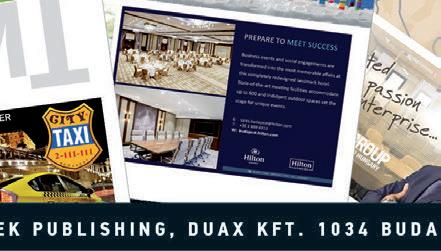

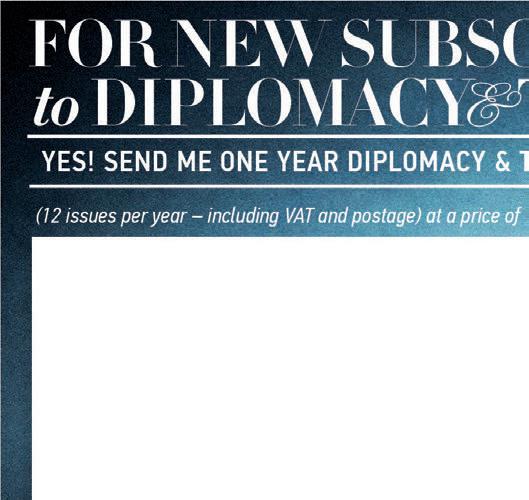
www.dteurope.com DIPLOMACY & TRADE| JANUARY 2021 15
photo by CSABA BARBAY AND BOGI JUHÁSZ / FLASHBACK PHOTO
Signature: Buyer: VAT Number: Address: Name: Phone: E-mail:

































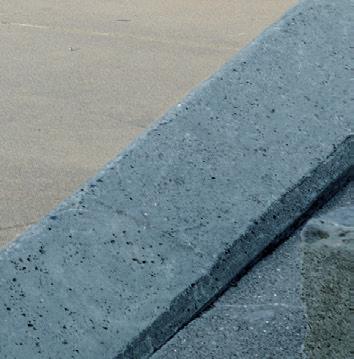









The Audi RS Q8. Find out more at progress.audi Future is an attitude
Fuel consumption,
urban XX.XX–XX.XX l/100 km |
XX.XX–XX.XX g/km Fuel consumption, combined: 12,1 l/100 km. CO2 emissions, combined: 276–277 g/km. The values specified are based on the default factory setup recorded at the type approval and are valid at the time the ad is posted. The designated values were measured according to WLTP. They do not apply to individual vehicles and are not part of the information notice, but serve the purpose of comparing different types of vehicles, in accordance with the provisions of Regulation (EC) No 715/2007. These values are influenced by additional equipment, accessories, driving habits and other non-technical (e.g. environmental) factors. The motor vehicle shown in the picture is an illustration and may contain additional equipment.
Some just see sheer speed. We see inspirational engineering.
combined:
CO₂ emissions, combined: extra urban
Some just see sheer speed. We see inspirational engineering. The Audi RS Q8. Future is an attitude






































































































































































